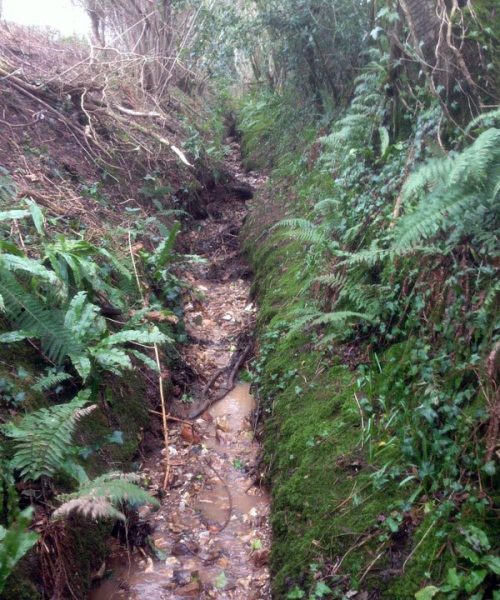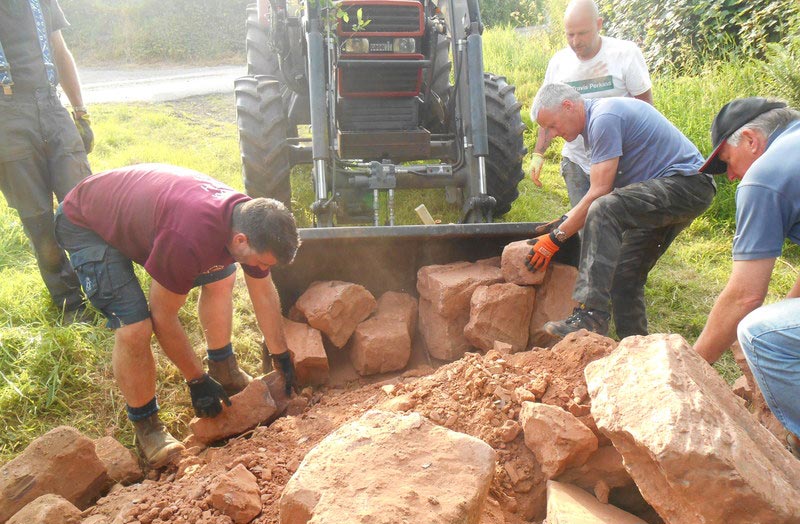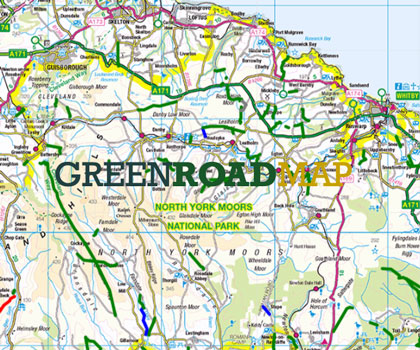A crater deeper than a bike. A £30k repair bill. A council out of cash. A recurring TTRO. With odds stacked this high, Blind Lane was surely lost? To Devon TRF, it sounded like the perfect challenge. Could they do the impossible? Ian Collins picks up the story.
TRF
We understand that you were instrumental in the work done to Blind Lane in Devon. Maybe you could begin by giving us a bit of background about your role in Devon TRF?
Ian
Yep. I started clearing lanes 10 years ago with Pops (my dad) and slowly built up a team of Devon TRF lane clearers who soon realised lanes could be cleared and opened by just simply getting out there and putting a bit of effort in. We as a group have progressed our relations with the local authority, building trust along the way on both sides. Learning how both sides operate has been key into our lane clearing activities.
TRF
So what was the problem with Blind Lane? Why did it need work and what would have happened if Devon TRF hadn’t got involved?
Ian
Well first you have to understand the geography along with the history of Blind lane. Problems started back well before 2009 with ever changing issues on land/road drainage from up above the lane. The lane sits nearly at the bottom end of a hill with a tarmac road leading any water + debris straight into its path before the road turns a corner thus leaving the water to run straight on through the lane.

Blind lane has succumbed to sheer natural forces pushing their way through an a unmetalled road with dire consequences. There have been some serious wash outs over the years resulting in a TTRO being placed back in 2012 simply due to water erosion which resulted in a four foot gully being carved most of the length of the lane. The banks and hedgerows to the fields either side were left in a very precarious state, with the odd collapse and land side in adverse weather.
TRF
Was it hard to convince the council to let you get involved? Not many TRF groups have such good cooperation with their local authorities, what makes you different?
Ian
The Council had a few meetings where various officials walked the site. It was deemed too expensive to repair with costs of £30K quoted for repairs which would have wiped out the total yearly budget for the PRoW warden in that area.
The wardens in Devon PRoW operate under their own knowledge of their own area which in turn leaves them a fairly free hand in decision making although they have a central manger in command which i guess would see some two way traffic to deal with issues on larger scales, but mainly its down to wardens to use their knowledge and common sense on handling individual cases.
Blind lane was closed by the area warden with a TTRO slapped on it for 18 months then renewed once this expired. Through lack of funds this was always going to be closed unless a miracle happened with funding or a massive amount of enthusiasm from Devon TRF and more importantly three VERY generous locals and a serious amount of good will to get this wonderful operation off the ground.
Devon TRF has a very good relationship with Devon PRoW and the warden had confidence in our proposals for repair. We made sure to keep the warden in the loop through the planning and the execution of the project.
Most importantly we had a very good dialogue with the locals who lived on and near the lane, this was really important, we wanted to make sure that they knew what was going on and in the end it meant that they were cooperative and willing to help as we all wanted to the achieve the same thing. We had 12 tonnes of stone delivered to the top of Blind Lane with the farmers permission and in the end this started a lot of interests and conversation from the locals, it was the easiest way of getting the word out! In the end, because a lot of the materials and labour were provided by DTRF the local warden and Devon PRoW couldn’t refuse an offer of free help.
TRF
What work did you actually carry out?
Ian
Thanks to a huge and very generous donation from DTRF member Chris Cole was greatly accepted by the project team. Chris delivered 12 tonnes of enormous stone to form 11 weirs within the gully running through Blind Lane. We worked through the summer evenings and made sure to let passers by know that the work was being undertaken for free by Devon TRF, a great opportunity to spread the word.
Chris Selway, a local farmer, has fields that run along side Blind Lane. He was very concerned about how the state of the lane might affect his land and agreed to work with us on the repair. Chris used is tractor (fitted with a mega front bucket) to help load the stone into the lane. We couldn’t have done this without his help. We used the stone to create weirs up to the original height of the lane at about 20 ft intervals which allowed us to fill the gaps afterwards.
It took several evenings to complete the weirs over the summer. It was pretty hard work so it took quite a while. Once this was complete we were ready for stage 2, filling in about 200 tonne of material all the way from one end of the lane to the other! How were we going to do that?
Chris the farmer put us in touch with another local, John, who just happened to be a trail rider and owned a 3 tonne digger. It took a bit of convincing but eventually I managed to sweet talk him round to helping volunteer, I think he was looking for an excuse to use the digger!
So we had Chris tipping the material in at the top of the lane with his tractor, John excavating with his digger and as luck would have it, Brian, a DTRF member who only lived 1/2 mile away had an old but wonderful 4×4 five tonne dumper in the garden. Perfect.
With all machinery in place we set to work. Within a day we had shifted over 180 tonnes of material and essentially repaired Blind Lane.




TRF
What is the future of the Blind Lane? Now that it is fixed does that mean it has been ‘saved’?
Ian
The weirs we constructed are designed in such a way as to trap any future run off material behind them and so increase the height of the lane whilst slowing down the forces of nature. This November we were visited by hurricane Angus and over 16 tonnes of material has formed behind the weirs. Some of the original material did wash out, but that’s to be expected and we will need to keep on top of this with our ongoing maintenance of the lane. It looks like we will need to put in a couple more weirs at the bottom of the lane.
This repair is definitely an ongoing project. It’s fantastic what we have achieved, but we need to keep an eye on how Blind Lane ‘beds in’ and react accordingly to any serious weather that we might get. The clever bit is that while some material is washed away, the majority is trapped by the weirs and so the lane maintains it’s depth which is what we wanted to achieve.
The TTRO on Blind Lane was lifted and it is now once again open for all users to enjoy. From the start of the project, where the lane was in such a poor state of repair, many people would have thought it would take a huge amount of money to fix and therefore never be re-opened. This project has shown that joint co-operation between DCC, DTRF and locals can ‘move mountains’.



